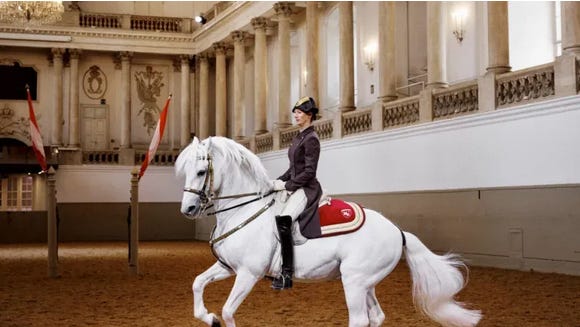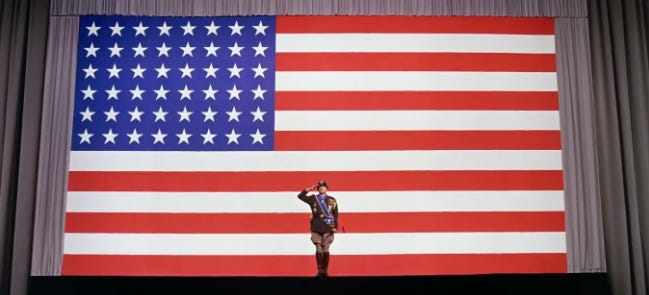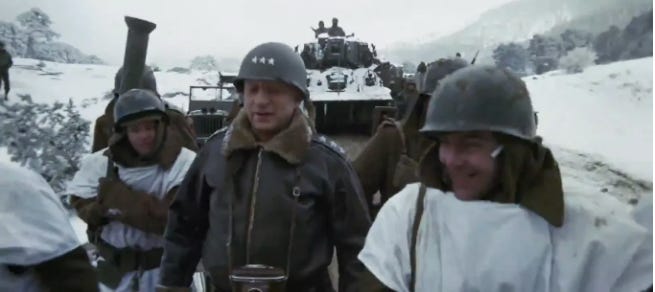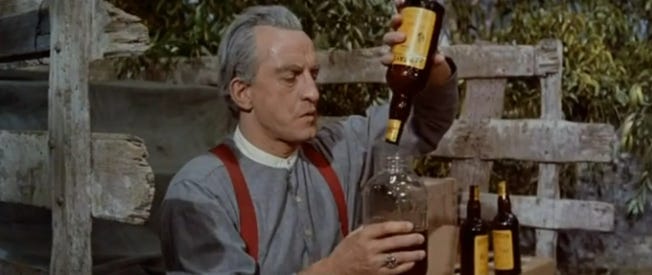It’s that opening scene that people remember. You know the one. The one that starts with this quote:
Be seated. Now, I want you to remember that no bastard ever won a war by dying for his country. He won it by making the other poor dumb bastard die for his country.
When you read that deranged quote and see that general standing there in front of that big-ass flag, you might think that Patton is a pro-war film that deifies its title character. Don’t be fooled: that wasn’t initial screenwriter Francis Ford Coppola’s intention.1 Instead, the film wrestles with Patton: his vanity, his brilliance, his hubris.
The plot covers the career of George S. Patton (George C. Scott) from his landing in Africa in 1942 through the end of World War II. Patton is part of the attack on Sicily2, winning a race against British Field Marshal Bernard Montgomery (Michael Bates) to Messina. Some of the bloom comes off Patton’s rose after he slaps a soldier with battle fatigue, accusing him of being a coward. Still, Patton is given command of the Third Army after D-Day and achieves his greatest victory during the Battle of the Bulge, marching his troops a hundred miles in two days to rescue Americans pinned down in Bastogne, Belgium.
But Patton is a warrior, and in the post-war environment, the boldness that served him on the battlefield now appears as madness. Once Berlin is taken, Patton refuses to denazify, arguing that the U.S. has been fighting the wrong enemy. “Leave it to me,” he says, “in ten days I'll have us at war with [the Russians] and make it look like their fault!” He is dismissed by General Eisenhower, the end.
Patton says and does shocking things and the movie does not downplay, excuse, or condone them.3 In fact, a big part of the film is the difference in temperament between Patton and General Omar Bradley (Karl Malden). Here’s Bradley on Patton: “There's one big difference between you and me, George. I do this job because I've been trained to do it. You do it because you love it.”
Rating: 8/10, Patton’s a poor dumb bastard but that’s kind of the point.
Cast and Crew
When George C. Scott died, you knew what film would be in the headline of his obituary.
This is what Scott is remembered for. And it wasn’t just for the performance: when he won the Oscar for Best Actor, he didn’t accept it4—the first time a performer had ever turned down an Oscar.
In 1964, we saw Scott in Dr. Strangelove, giving big Tim Robinson energy. Between that film and this, he made two straight comedies—Not with My Wife, You Don’t! (1966) and The Flim-Flam Man (1967)—along with John Huston’s epic The Bible…In the Beginning (1966). It was his performance as biblical patriarch Abraham that helped Scott land the role of Patton, and it was as Patton that he’d cement his legacy. We’ll see Scott again.
Karl Malden: we’ve seen his big ol’ nose three times, all in crackerjack second banana performances (A Streetcar Named Desire, On the Waterfront, and Birdman of Alcatraz). This was by design: he knew he wasn’t a leading man, but he once said he was determined “to be No. 1 in the No. 2 parts I was destined to get.”
After Patton, Malden headed to TV, starring in the Quinn Martin production “The Streets of San Francisco” (1972–1977) alongside Michael Douglas. The ‘70s had many, many, many police procedurals, and “The Streets of San Francisco” was, from what I can tell, certainly one of them. Malden was also known for his ads for American Express traveler’s checks, where he delivered the well-known line “ask for them by name!”
What’s a traveler’s check? Ask your parents.
The Trivia
Yes, yes, we have to talk about four-star general5 George S. Patton, “Old Blood and Guts,” but lemme tell you—I don’t wanna. So we’re gonna intersperse “Patton facts” with related but more fun “Non-Patton facts.”
Patton fact #1: Patton represented the U.S. at the 1912 Olympic Games in Stockholm, competing in modern pentathlon.
Non-Patton fact #1: Modern pentathlon was created by Pierre de Coubertin, the father of the modern Olympic games, and introduced to the Olympics in 1912. It riffed on the pentathlon from the ancient Olympics, which consisted of a foot race, javelin throw, discus throw, long jump, and wrestling. Modern pentathlon’s a bit more eclectic, as it was created to showcase the skills needed for a cavalry officer stuck behind enemy lines. Through 2024, modern pentathlon was the following five events (note that distances have changed slightly):
Épée fencing
Swimming (200m)
Horse riding on an unfamiliar horse: initially a cross-country race, replaced in 1988 with show jumping
Shooting: initially pistol, replaced by air pistol and then laser pistol
Cross-country running (3200m); combined with shooting in 2016.
In upcoming Olympics, show jumping will be replaced by an obstacle course that resembles “American Ninja Warrior”; the change was in part due to competitors occasionally punching their horses. How it works now is that the results of the fencing, swimming, and obstacle course events give some competitors a head start in the “laser run” (a combination of shooting and running), with the winner of the laser run winning the whole shebang.
Wikipedia notes that “in 2021, modern pentathlon consistently had the least TV viewers of all Olympic sports, and also ranked at the bottom for internal Olympic measurements of social engagement.” Even this video of the 2025 Modern Pentathlon World Cup Men’s Finals only has 5,000 views. It’s a bummer—modern pentathlon should be cool, but it just…isn’t.
Patton fact #2: Patton wrote a saber exercise manual and introduced what was popularly called the “Patton saber.”
Non-Patton fact #2: Let’s discuss the three forms of Olympic fencing: foil, épée, and saber. Here are the differences:
Foil: the lightest weapon; can only poke the torso
Épée: can poke anywhere
Saber: can only hit above the waist but can slash as well as poke.
Most people specialize on only one weapon, but that begs the question: has anyone won medals with all three? The answer? It’s rare, but Nedo Nadi won golds across all three weapons in the 1920 Olympic games. There aren’t really any modern athletes who have had success with multiple weapons, and if someone comes along who does, it’ll be a Shohei Ohtani-esque feat.
You may know a few fencing terms already. En garde tells the fencers to assume their starting position6 while touché means touch (when the ref indicates there’s been a hit). A parry is where a fencer blocks an opponent’s attack and a riposte is an attack after parrying. The fencers face off on the piste, a long, narrow strip.
Patton fact #3: Patton saved the Spanish Riding School and its entire herd of Lipizzaner and Arabian horseys.

Non-Patton fact #3: Well, let’s first figure out the name. The Spanish Riding School7 is in Vienna. It was named for the Spanish horseys from which the Lipizzaners were bred. The Lipizzaners, meanwhile, were named for the town of Lipica (“Lipizza” in German), which is in Slovenia.
What do they teach at the Spanish Riding School? Horsey prancing, also known as dressage.8 The name comes from the French word for “training” and it involves prancing your horsey through a series of specific movements. As with every sport, it has a bunch of jargon around it; you can see some of the specific horsey prancing terms here.9
Some of that Patton story is shown in the Disney live-action film Miracle of the White Stallions (1963). After Vienna is retaken by the Allies, the director of the School tries to convince Patton to rescue horseys in Czechoslovakia that might be eaten by the Russian Army. To convince Patton to save the horseys, the school performs dressage for him and he goes and saves ‘em.
Patton fact #4: Patton was one of the generals who led troops during the invasion of Sicily.
Non-Patton fact #4: Well, to even get the invasion to work, first the deception of Operation Mincemeat occurred. British intelligence dressed up a corpse as a Royal Marine and planted on him papers documenting a fake upcoming invasion of Sardinia and Corsica. They then dumped the corpse off the coast of Spain, and when the Germans found him, they shifted their defenses to those other islands.
This set up Operation Husky, the invasion of Sicily. It was the largest single assault landing carried out by the Allies during the war: over 180,000 soldiers went ashore on July 10th, 1943, compared with the 156,000 troops who landed in Normandy on D-Day.
Soon the Allies crossed the Strait of Messina, Benito Mussolini was deposed10, and the new Italian government surrendered to the Allies. In response, the Germans forcibly disarmed the Italians and created a fascist puppet state (the Italian Social Republic, also known as the Salò Republic) in Northern Italy. The war then continued for a while.
Odds and Ends
Scott reprised his role as Patton in the TV film The Last Days of Patton (1986), which covered Patton’s time from his removal from the post of military governor of Bavaria to his death in a traffic accident in Germany in 1945…John Wayne really wanted to be cast as Patton…Omar Bradley was known as “the G.I.’s general”…in the film, Patton asserts that Palermo is the most conquered city in history…the film mentions Ernie Pyle, a reporter during the war who was killed in 1945…Patton receives admiration in Ajaccio, the capital of Corsica…“all glory is fleeting”…Franklin Schaffner directed; he won the first directing Emmy for the 1954 TV version of 12 Angry Men…Patton says “Americans have never lost and will never lose a war,” lol.
And here’s more boring Patton stuff I spared you from in the Trivia section: he served with John J. Pershing in Mexico; he formed the U.S. Army's first tank training school; he’s buried in Luxembourg with soldiers who died during the Battle of the Bulge; the General George Patton Museum of Leadership is at Fort Knox; Patton’s son commanded the 11th Armored Cavalry in Vietnam. Okay, no more Patton, we’re done.
Yeah, Francis Ford Coppola wrote Patton. More on him when we get to The Godfather (1972). Boy, I have no idea what we’re gonna do with that one.
The well-read Patton states the belief of ancient Greek statesman Alcibiades: “if Syracuse falls, then Sicily, then Italy.”
Scott argued against the “childish and damaging unnatural competitiveness” of awards and had previously declined nominations for his performances in Anatomy of a Murder and The Hustler.
You should know the ranks of different U.S. Army generals.
A one-star general is a brigadier general
A two-star general is a major general
A three-star is a lieutenant general
A four-star is just a general
A five-star is general of the army.
If you read closely, you might have noticed that a lieutenant general outranks a major general, despite a major outranking a lieutenant. I can’t help you with that.
After that, you’ll hear “Prêts? Allez!”—French for “Ready? Go!”
Wikipedia notes that the Spanish Riding School is one of the “Big Four” classical riding academies. The other three are the Cadre Noir, the Portuguese School of Equestrian Art, and the Royal Andalusian School. I think knowing one riding school is probably enough, but, y’know, maybe not.
Note that dressage is one of the three Olympic horsey events. The other two are eventing and show jumping.
One specific term I’m gonna put in the chamber is piaffe, where the horsey basically trots in place. At the Spanish Riding School, there’s a specific routine called the “airs above the ground,” a horsey dance that includes the capriole, the courbette, the mezair, the croupade, and the levade (though these moves aren’t done in dressage competition any more).
Mussolini was arrested by the new Italian government headed by Pietro Badoglio but was later rescued by German commandos. Don’t worry, it didn’t work out for him.






Major General was originally Sergeant Major General, which is why it's outranked by a Lieutenant General.